Cocos Island
Out of the mist......appears the vertical cliffs of the island from the movie Jurassic Park. The cliffs are alive with waterfalls dropping to the rocks and ocean below. At any moment one expects to see a Brontosaurs poke its head from behind a towering palm. Sharks, sharks, sharks is what Cocos Island is all about. It is the large schools of Scalloped Hammerhead sharks that draw us to these waters.
Cocos Island -- A Trip to the Past
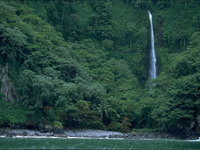 Out of the mist......appears the vertical cliffs of the island from the movie Jurassic Park. The cliffs are alive with waterfalls dropping to the rocks and ocean below. At any moment one expects to see a Brontosaurs poke its head from behind a towering palm.
Out of the mist......appears the vertical cliffs of the island from the movie Jurassic Park. The cliffs are alive with waterfalls dropping to the rocks and ocean below. At any moment one expects to see a Brontosaurs poke its head from behind a towering palm.
Sharks, sharks, sharks is what Cocos Island is all about. As wild as the island is on land, below the sea the adventure offers more of everything. More schools of Big-eye Jacks, Goldrimmed Surgeonfish and Almaco Jacks, more turtles, more manta rays, more dolphins and more sharks. Schools of Whitetip sharks are seen on almost every dive. Solitary Slivertips, Blacktip sharks and small packs of Silky sharks patrol the waters. But it is the large schools of Scalloped Hammerhead sharks that draw us to these waters.
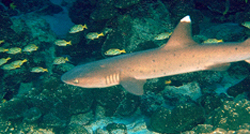
Located 300 miles out into the Pacific off the coast of Costa Rica, Cocos Island is an advanced diving experience where palegics fill the waters. When the weather is uncooperative, there are only three dives sites sheltered enough. The front side of Mannelita Island, Sphinx and Dirty Rock are the best that Cocos offers and we never tired of the adventure they provided.
As we descended, the head of the Sphinx came into view. Within the deep cervices of the rock, a school of creolefish hung motionless. A small and friendly turtle gently swam between Annie and me. As the current is generally very swift, I moved, one hand at a time, towards the point. The strong current funneled past the rock as more than 200 Whitetip Sharks circled to get in line for the mating ritual. Just in front of me, a large male with clphpers ready, bit at the sea in its instinctive mating gesture. Round and round the males went, looking for the right opportunity to be selected.
Something was happening. The Whitetip sharks that usually circled within the strong current to hold their position turned and fled. They darted past me in an attempt to clear the area. All of a sudden a massive flow of jacks appeared cascading down at 45 degrees into the thermocline below. The river of fish kept coming and coming, numbers in the tens of thousands.
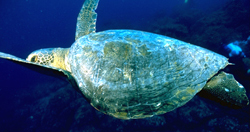 In hot pursuit, a pod of dolphins passed just below Annie as she hung motionless witnessing the unfolding event. The dolphins were chasing the jacks and a school of yellowfin tuna were chasing the dolphins. Holding up the rear, a small Hawksbill Turtle swam past with a "don't leave me" expression on its face. As quickly as it began, it was over. The real drama played out a part of the ocean beyond our meager ability to follow. And so ended a week of diving Cocos Island where the marine drama continues to play out its daily episode and we are fortunate for our small glimpse.
In hot pursuit, a pod of dolphins passed just below Annie as she hung motionless witnessing the unfolding event. The dolphins were chasing the jacks and a school of yellowfin tuna were chasing the dolphins. Holding up the rear, a small Hawksbill Turtle swam past with a "don't leave me" expression on its face. As quickly as it began, it was over. The real drama played out a part of the ocean beyond our meager ability to follow. And so ended a week of diving Cocos Island where the marine drama continues to play out its daily episode and we are fortunate for our small glimpse.
Bat Island Diving
So diving with all the sharks at Cocos Island was not enough. Spend a few days with the giant and dangerous Bull Sharks of Bat Island. Of the more than 260 species of sharks in the world only three have been known to kill humans. These are the Great White, the Tiger and the Bull Sharks. A half a dozen others have been observed exhibiting aggressive behavior but without authenticated kills.
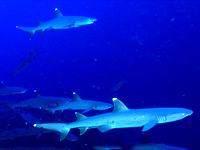
The Bat Islands, a little more than one hour boat ride from Playa Del Cocos in the Guanacaste District of Costa Rica, affords an unique opportunity to dive in open waters with both the Bulls and the Tigers. There Skyler Chapman of Rich Coast Diving will take you on an open water dive to meet the Bull sharks first hand.
Skyler has lead over 300 dives and has rarely encountered a life threatening situation. Only once did a large Bull arch its back, sheath its eyes and approach within easy striking distance. The most dangerous part of the dive is returning to the boat where your bottom-half is exposed below the surface. Precautions are taken to minimize the danger of diving in the open waters with these massive sharks. Visibility is an unknown and can vary from zero to 5 feet, 15 feet being the norm.
How does one prepare to dive with as many as 30 of the most dangerous sharks in the world? As Skyler puts it, 'you must follow my dive briefing precisely or you may never dive with me again.' I was not clear whether he meant you are grounded or you are shark bait.
Not only should you have had some experience diving with sharks but you should not be one of those people that panic and flee at the first sight of a shark. After signing over to Skyler all your valuables, you are ready for the dive briefing.
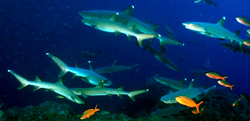 The dive is actually quite simple but includes a couple of special procedures. The entry and decent must be rapid, remaining in open water for the least amount of time. First all air is sucked from the buoyancy compensator and then the synchronized roll is followed by a head-first kick to the bottom must be done in tight formation. Once on the bottom, the group crawls along the bottom with Skyler in the lead. The return to the surface is done also in tight formation with divers back-to-back and eyes scanning for curious sharks. At the surface, the idea is to quickly jump into the boat and pull your gear in afterwards.
The dive is actually quite simple but includes a couple of special procedures. The entry and decent must be rapid, remaining in open water for the least amount of time. First all air is sucked from the buoyancy compensator and then the synchronized roll is followed by a head-first kick to the bottom must be done in tight formation. Once on the bottom, the group crawls along the bottom with Skyler in the lead. The return to the surface is done also in tight formation with divers back-to-back and eyes scanning for curious sharks. At the surface, the idea is to quickly jump into the boat and pull your gear in afterwards.
We descended as instructed all at once and with rapid, non-stop, rapid clearing all the way to the bottom. As we assembled in a tight group flattened on the rock, we scanned the area for a hint of the big ones. The visibility was less than 10 feet which heightened the adrenaline level as they could see us but we could not see them. Laying there, the anxiety increased as no sharks appeared within our vision.
After ten minutes we started to edge over to the point in hopes of sighting some Bulls. As we cautiously creep across the bottom, we were ever vigilant for at any moment we expected to see a huge body emerge from the murk. Below, morey eels and cleaner wrasses go about their daily activities without concern.
We rounded the corner and still no sharks. Just when we thought that this was one of those no-show dives, an 8-foot Bull darted from the shadows. It drifted within a few feet in time to squeeze off a single photo before disappearing into the dark.
We ascended in tight formation, back-to-back, watching for sharks. The open water ascent was by far the most dangerous part of the dive as sharks prefer to strike at our safety stop. Skyler gave the word and we darted for the safety of the boat. Onboard we rested recounting the feelings of diving in the dark murky water with the big Bull Sharks.
I don't know which is worst, diving in low visibility waters where you have no idea how many sharks are circling or in good visibility waters where you can see all the sharks at once. Either way, the Bat Islands dive promises to bring your adrenaline level to an all time high.
Turtle Wonderland
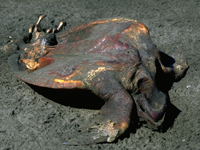 Home to four of the seven species of marine turtles, Costa Rica is rich in warm sand beaches that serve as hatcheries for Olive Ridley, Hawksbill, Green and the giant Leatherback turtles. Poaching is still a major problem but local action groups are beginning to provide some protection especially on a few of the more important beaches.
Home to four of the seven species of marine turtles, Costa Rica is rich in warm sand beaches that serve as hatcheries for Olive Ridley, Hawksbill, Green and the giant Leatherback turtles. Poaching is still a major problem but local action groups are beginning to provide some protection especially on a few of the more important beaches.
Along the Pacific Coast there are two major breeding areas, north at Santa Rosa National Park and at Ostional National Wildlife Reserve. Here Olive Ridley turtles come ashore in the thousands in 8-day stretches to lay their eggs during the months of October through February. These massive arrivals, called arribadas, occur two to four weeks apart. In addition, the beaches, a little south, at Playa Grande are home to the largest of all marine turtles, the Leatherback
Marine researchers from the United States and Canada with the assistance of Earthwatch volunteers are studying the behavior of the female Leatherbacks that use the Playa Grande beaches. Research conducted between October and February each year provide valuable insight into the migration patterns, reproductive process and health of the turtles.
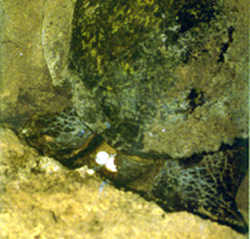 Depending on the number of Earthwatch teams available, the beach is divided into equal segments and is walked between two hours before and after the high tide. Sometimes the Leatherbacks are seen for longer periods requiring the teams to stay up all night so not to miss a single female.
Depending on the number of Earthwatch teams available, the beach is divided into equal segments and is walked between two hours before and after the high tide. Sometimes the Leatherbacks are seen for longer periods requiring the teams to stay up all night so not to miss a single female.
The egg laying process takes between one to three hours during which the female crawls from the surf to above the high tide line and digs a three-foot hole. She deposits approximately 60-80 yoke eggs and some 20 yokeless eggs. The yokeless eggs are included in all clutches and although the actual reason is not clear, it is believed that these eggs help control the temperature of the nest.
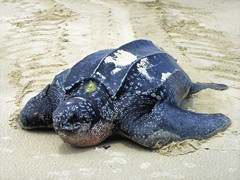 The Earthwatch teams monitor the egg laying process taking several types of measurements including the number of eggs, the turtle's size as measured by the shell and blood samples. The animal is tagged with a bar-coded chip attached to the shoulder muscle and one on the rear fin. Blood samples measure various hormone levels and contribute to the overall understanding of breeding behavior and general health.
The Earthwatch teams monitor the egg laying process taking several types of measurements including the number of eggs, the turtle's size as measured by the shell and blood samples. The animal is tagged with a bar-coded chip attached to the shoulder muscle and one on the rear fin. Blood samples measure various hormone levels and contribute to the overall understanding of breeding behavior and general health.
The nests are monitored for heat as the sex of the hatchlings are determined by the temperature of the nest. An average temperature of less than 32 degrees Centigrade will yield more males. As the actual ratio of adult males to females in the wild is not known and infant survival rates are only crudely estimated, the characteristics of adult Leatherback populations are unknown.
Thermistors are placed in the nest to measure the temperature at different depths. About 12-15 sensors are placed in the nest as the female covers up her eggs. Noon each day the different temperatures are recorded and correlated with other factors such as eggs hatching success rates and length of incubation period. This detailed temperature pattern adds to other data in providing a better picture of the hatching process.
Little is known about the adult male Leatherback turtles as they spend all of their lives in the open ocean. Only one pair of Leatherbacks in the 1980s have been observed mating in the wild. Marine behavior studies are conducted on the females with opportunities to tag and attached radio transmitter devices when they come ashore to lay eggs. As they frequent the same beach 5-6 times in a breeding season, the data from devices attached to the turtles can be collected several times for a single female.
Dr. David Jones, of the University of British Columbia in Vancouver, Canada, has been studying the heart rates of turtles as they dive to various depths. Attaching a device that logs information about the depth, time and heart beats per second, he is able to determine the metabolism rates under different activities and level of stress. This type of information will lead to a better understanding on the impact of fisheries on turtle survival.
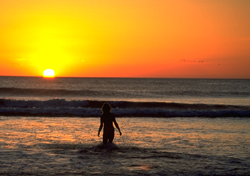 In 1990, an area 4.5 kilometers surrounding Playa Grande became the Taminado Marine Refuse. Since that time, poaching has been signficantly reduced through enforcement and public education. Although poaching has been reduced within the confines of the refuse, adjencent beaches still suffer near complete poaching.
In 1990, an area 4.5 kilometers surrounding Playa Grande became the Taminado Marine Refuse. Since that time, poaching has been signficantly reduced through enforcement and public education. Although poaching has been reduced within the confines of the refuse, adjencent beaches still suffer near complete poaching.
The turtles of Costa Rica are a natural resource to be enjoyed. They actually play a much bigger role in maintaining a healthy environment. As Frank Paladino, Professor of Biological Sciences at Indiana University, puts it, "humans must start practicing biodiversity and live with the environment around us, this is our biggest concern for the future of humanity."
Find out more about the work of Dr. Frank Paladino, Professor of Biological Sciences at Indiana University.
